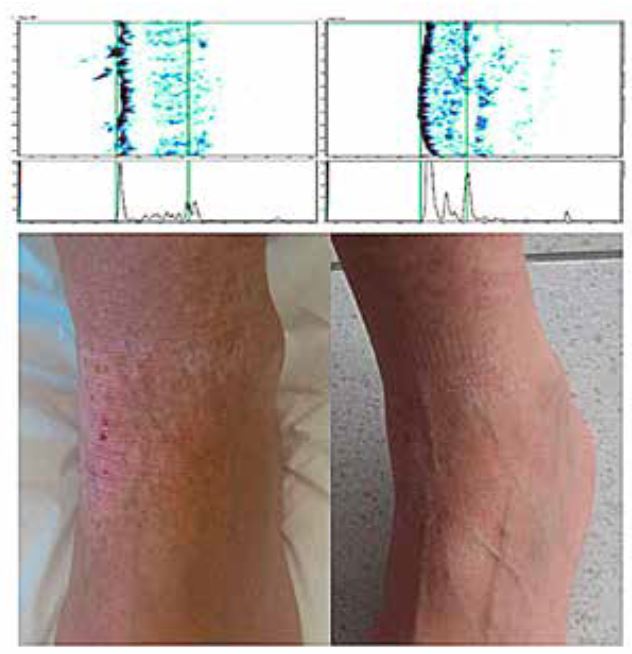Figure 1: Skin condition before the start of treatment and after 14 weeks. Identification of incompatible foods using the Alcat Test and instituting a corresponding elimination/rotation diet based on test results. Up Ultrasound/Collagenosom – below light level imaging (F. Angehrn, MD, Director, Klinic Piano, Bienne,Switzerland)
The outer skin is immunologically related to the intestinal mucosa, which may be thought of as the body’s inner skin. Therefore, disturbances in the gut may present as blemishes, acne or skin diseases such as eczema, atopic dermatitis and urticaria. Non-infectious skin diseases are usually caused by inflammatory processes in the body. Therefore, if inflammation is reduced, symptoms might also be reduced.
The Alcat Test can identify potential inflammatory responses of white blood cells, mainly the neutrophils, caused from food and other environment triggers. Thus, for skin problems, testing of chemicals and molds, in addition to foods, can also reveal unsuspected triggers in sources such as cosmetics, shampoo, toothpaste, detergents etc.
Eczema is a general term for non-infectious inflammations of the skin 1. One of the most common forms of eczema is neurodermitis (atopic dermatitis or “atopic eczema”). It can be caused by internal (genetic predisposition) or external (environment) triggers. Approximately 12% of the world population is affected by this chronic, relapsing, and very itchy rash at some point during childhood 2. A typical sequence of rash, redness, blistering, oozing, crusting, flaking is observed and occurs mostly at the joints. Although its cause is unknown, the condition appears to be an abnormal response of the body’s immune system 1. In people with eczema, the inflammatory response to irritating substances overreacts, causing itching and scratching.
In many cases eczema flare-ups may be prevented through careful management of the diet. Another beneficial approach is to ensure that you have an adequate supply of nutrition that supports good healthy skin 3, 4.
Psoriasis also belongs to the category of non-infectious endogenous (internal) skin diseases and affects around 2% of the population worldwide 5. It is a multifactorial condition usually autoimmune or with a genetic predisposition 6. The cause of psoriasis is not yet known but scientists suspect dysregulation of the immunological defense system 5. It is typical present at the joints as fingers, elbows or knees but it can also spread throughout the whole body. The partially itchy body parts are red, sharply defined and form white flakes.
Hives or urticaria, is a skin disease with red elevations of the skin (hives). It is a complex condition with unknown origin. It is known that inappropriate activation and degranulation of mast cells play an important role 7. Recent studies presented an involvement of a disturbed innate immune system with altered chemokine-cytokine network 7. The itching is produced by histamine and other inflammatory mediators.
The affected areas resemble how the skin looks following contact with nettles. Hence the name “hives”. The known triggers include: food or chemical food additives, as well as sensitivity to external factors such as pressure, temperature, sunlight, bee and wasp stings, medicines, and others.
Test recommendations for skin conditions
|
What test |
Why? |
| Alcat Test for food & chemical sensitivity
PreviMedica Program
LINK
|
Validation studies show that the Alcat Test can have very positive effects on skin problems:
|
| Adrenal Stress Profile to determine the levels of the stress related cortisol to that of DHEA, (both of which are produced by the adrenal glands). | Stress can cause inflammation and thus may cause skin disorders.
|
Effectiveness and validation of the Alcat Test
Beginning in 1988, and carrying through to the present, several clinical studies have been performed to evaluate the effectiveness of the Alcat Test. Some of which were “double-blinded*” to see how well the test results correlate with actually eating the food.
A valid test for food intolerance should show the effect of food substances on those cells of the immune system which are associated with the inflammatory process.
(Note to us: it would be good to link to references that link neutrophil activation to certain disease conditions, LINK to Alcat Test immunology section?).
If the test results are valid there should be in a concordance with symptoms (e.g., gastrointestinal complaints), and correlate with double blind oral exposure.
(*Double-blind studies: To obtain an unbiased outcome the study must be carried out in double blind fashion wherein neither the doctor (investigator) nor test subject knows whether the food they are re-introducing has been indicated by the blood test as being either positive or negative. The test results are evaluated to see if they correlate with this, the, “gold standard” – a double blind oral challenge. This is a rigorous and time consuming protocol that yields an objective evaluation of both the sensitivity and the specificity of the test.)
Why is that important?
This is important because you want the test to correctly identify reaction provoking substances; but, you also do not want the test to show false positives. The first parameter is called, “sensitivity”. The second is called, “specificity”. A false positive would cause you to needlessly eliminate a safe food.
Scientists have shown that in patients with irritable bowel syndrome, atopic eczema, allergic rhinitis or migraine the Alcat Test can detect those foods that cause the above symptoms. The Alcat Test has shown high correlation with double-blind oral challenges: 83.4% withfoods. and 96% with food additives
Link studies
- High Correlation of the Alcat Test Results with Double-blind Challenge (DBC) in Food Sensitivity(P. Fell, Bostoff et al, 1988 and published in the Annals of Allergy)
- Diagnostic Value of Alcat Test in intolerance to food additives compared with double-blind placebo-controlled (DBPC) oral challenges ( Hoj, J Allerg Clin Immun 1 (3); 1996)
More detail: Scientific Dossier p. 14-16
Reproducibility of the Alcat Test
Drs. P. Potter and H. Steinmann of the University of Cape Town, South Africa conducted an Alcat Test reproducibility study in 1994. The study found high reproducibility (95%) of both positive and negative test results. . Reproducibility of the Antigen Leukocyte Cellular Antibody test (Alcat) – Statistical Analysis, Summary Statistics & Scientific Report
A second Alcat reproducibility study was conducted at the University in Bloemfontein, South Africa by Dr. WML Neetling and Dr. AM Kachelhoffer, January to April, 1998.
The study analyzed 10 consecutive patients. Of these, 2 patients had no prior allergies. The balance reported various symptoms such as migraine, asthma, and IBS. Using the Alcat Test, 1,300 analyses of 4,989 data points were performed, testing responses to 130 antigens. The study demonstrated 92% reproducibility.
Parexel Medstat Final Statistic Report
Study of the Alcat Test in 10 subjects tested twice: 1000 data points:
- Reproducibility: 97% in Cohort A, 99% in Cohort B. Overall,
- 983 of 1,000 Alcat Test data points (98.3%) were reproducible under the conditions investigated by the study. The study demonstrated the statistically significant reproducibility of the Alcat Test results.
- Study comparing the Alcat Test results with flow cytometry and microscopy. Gitte Jensen, NIS Labs (Natural Immune System) Oregon, USA, 2009
More detail: Scientific Dossier p. 17 No 1-4
Studies of the Alcat Test and its use with skin disorders
Investigators De Amici M, Berardi L, Castello, Mantegna, Giunta, Ronzi, and Vignini A concluded in a study of 35 patients that an elimination diet based on Alcat Test results improves symptoms in 66% of patients suffering from skin conditions such as Urticaria, Angioedema and Dermatitis. Presented at the 30th Congress of the European Academy of Allergy and Clinical Immunology, 11-15 June 2011 – Istanbul, Turkey, and Published in Allergy Volume 66, Supplement s94, June 2011 – pg. 63, abstract 553
More detail: Scientific Dossier p. 18. Nr. 1
-
Food intolerance in patients with cutaneous diseases: diagnostic value of the Alcat Test
Investigators Berardi L, De Amici M, Vignini A, Torre C and Mosca M studied 14 patients affected by cutaneous diseases with negative allergic tests (prick and/or RAST), who were Alcat tested. After a 2 month elimination diet based on the Alcat results, 86% of patients exhibited a dramatic improvement in symptoms, while 14% showed no change or did NOT follow the diet. Presented at the 28th Congress of the European Academy of Allergy and Clinical Immunology, 6-10 June 2009 – Warsaw, Poland. Published in: Allergy, Volume 64, Supplement 90, 2009 – pg. 490, abstract 1281.
More detail: Scientific Dossier p. 18, Nr. 5
-
Food Intolerance in Patients With Angioedema and Chronic Urticaria: An Investigation By Rast and Alcat Test
Investigator Hoj L studied 56 patient, who concluded that an Alcat Test based elimination diet coupled with elimination of RAST positive foods and food additives resulted in symptom improvement for 45 patients. Elimination diets based on Alcat Test results produced complete remission in 45 patients and remission of angioedema but not chronic urticaria in 5 patients.
Presented at the 16th European Congress of Allergotogy and Clinical lmmunology Madrid, Spain: June 25.30,1995. Published – European Journal of Allergy and clinical Immunology Supplement. Number 26, Vol. 50. 1995.
More detail: Scientific Dossier p. 20, Nr. 14
-
Prevalence of Food Allergy and Intolerance in Children Based On MAST CLA and Alcat Tests.
Investigators Buczylko K, Obarzanowski, Rosiak K, Staskiewicz G, Fiszer A, Chmielewski S, and Kowalczyk J performed a single blind study with 56 children with atopic disease; they were investigated for IgE allergy and screened for food sensitivities using Alcat. Foods were removed from the patients diets based on both forms of testing. Frequently, only the Alcat Test oriented diet gave symptom improvement. Published in Advances in Medical Sciences; Formerly Roczniki Akademii Medycznej w Bia?ymstoku Volume 40, Number 3, 1995.
More detail: Scientific Dossier p. 19, Nr. 11
-
Outcome study in 353 consecutive patients following the Alcat Test Diet
Observational study conducted in Copenhagen at the Allergy Clinic Charlottenlund, Denmark (1996, unpublished)
More detail: Scientific Dossier, p. 20, Nr. 12
-
Dr. Geldenhuys, 1997 in Johannesburg, described data collected from his patients treated with diets based upon their Alcat Test results.
This randomized study followed 274 patients with different symptoms who adhered to a diet plan based on their individual Alcat Test results. The percentage of patients that experienced improvement or complete recovery from their health complaints was as follows:
- 78% Migraine
- 77% Arthritis
- 67% Eczema
- 71% Intestinal cramps
- 71% Chronic fatigue
- 73% Diarrhea/constipation
- 62% Chronic sinusitis
More detail: Scientific Dossier, p. 24, Nr. 21
-
Alcat Test Results in the Treatment of Respiratory and Gastrointestinal Symptoms, Arthritis, Skin and Central Nervous System
Mylek et al., Rocz Akad Med Bialymst. 1995; 40(3): 625-629: This study followed 72 patients with complaints thought to be attributable to food intolerance. They were prescribed elimination diets based on their Alcat Test results. The results of the study showed an overall improvement in symptoms (number of patients expressed as a percentage) for
- 83% Arthritis
- 75% Urticaria, gastroenteritis, bronchitis,
- Migraine (70%),
- Chronic fatigue syndrome (60%),
- Asthma (50%),
- Atopic dermatitis (49%),
- Rhinitis (47%)
- Hyperactivity (32%).
The investigators concluded that an elimination diet based on this non-invasive method can significantly improve the symptoms of various ailments. In their experience, symptoms resolve in in 50-83% of patients following an Alcat informed diet.
More detail: Scientific Dossier p. 20, Nr. 13
-
The Alcat Test – A Guide and Barometer in the Therapy of Environmental and Food Sensitivities
172 patients (Dr. BA Solomon, Environmental Medicine, Vol. 9, Number 2, 1992:2-6).
Literature
1 Darsow U, Raap U, and Ständer S. Itch: Mechanisms and Treatment. Chapter 3 Atopic Dermatitis. Carstens E, Akiyama T, editors. Boca Raton (FL): CRC Press; 2014.
2 An JG, Liu YT, Xiao SX, Wang JM, Geng SM, Dong YY. Quality Of Life of Patients with Neurodermatitis. Int. J. Med. Sci. 2013, Vol. 10.
3 el-Kholy MS, Gas Allah MA, el-Shimi S, el-Baz F, el-Tayeb H, Abdel-Hamid MS. Zinc and copper status in children with bronchial asthma and atopic dermatitis ; The Journal of the Egyptian Public Health Association . J Egypt Public Health Assoc. 1990;65(5-6):657-68.
4 Javanbakht MH, Keshavarz SA, Djalali M, Siassi F, Eshraghian MR, Firooz A, Seirafi H, Ehsani AH, Chamari M, Mirshafiey A. Randomized controlled trial using vitamins E and D supplementation in atopic dermatitis. J Dermatolog Treat. 2011 Jun;22(3):144-50.
5 Cai Y, Fleming C, Yan J. New insights of T cells in the pathogenesis of psoriasis. Cell Mol Immunol. 2012 Jul;9(4):302-9.
6 Enamandram M1, Kimball AB. Psoriasis epidemiology: the interplay of genes and the environment. J Invest Dermatol. 2013 Feb;133(2):287-9.
7 Jain S. Pathogenesis of chronic urticaria: an overview. Dermatol Res Pract. 2014;2014:674709.
















